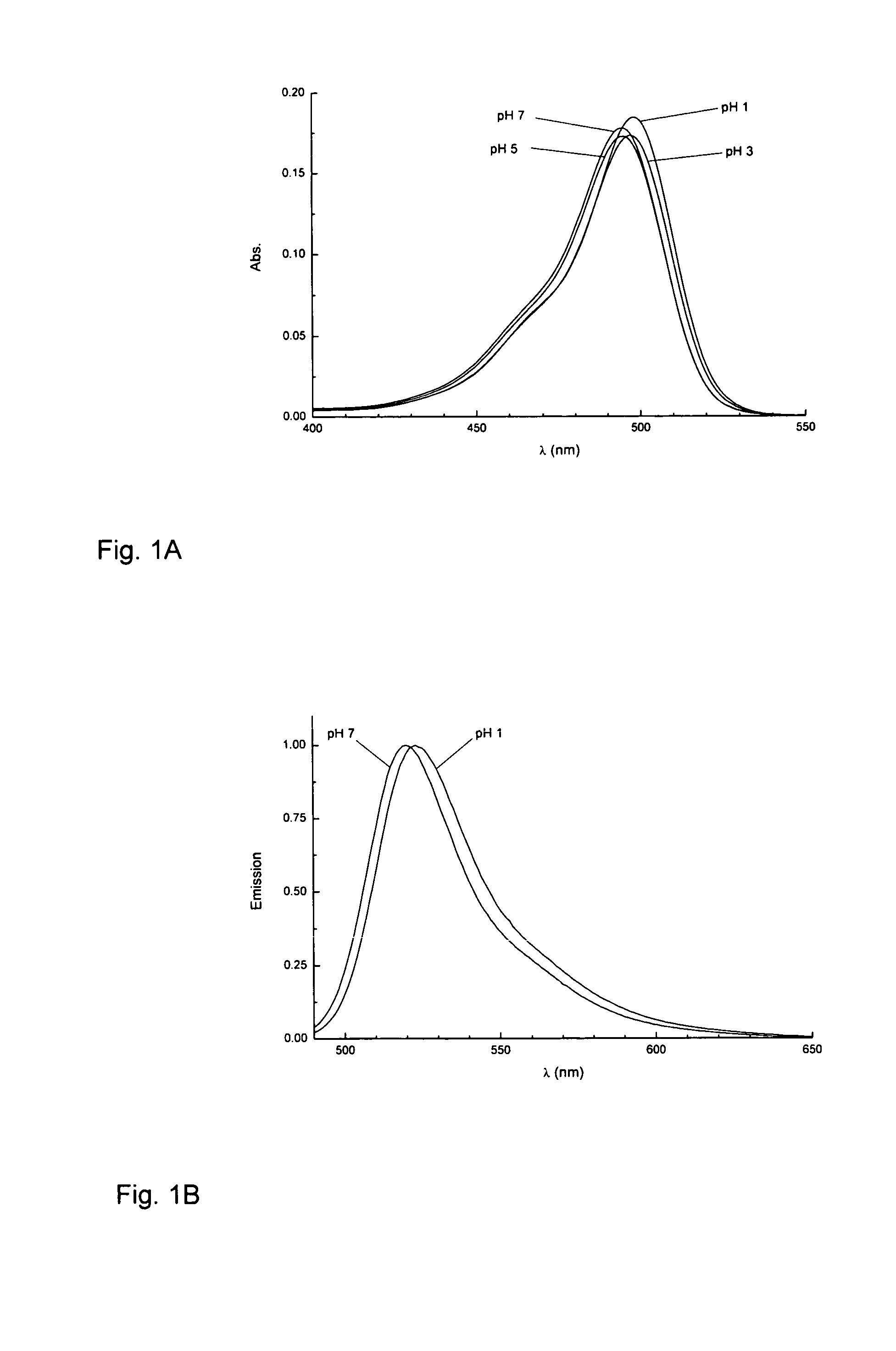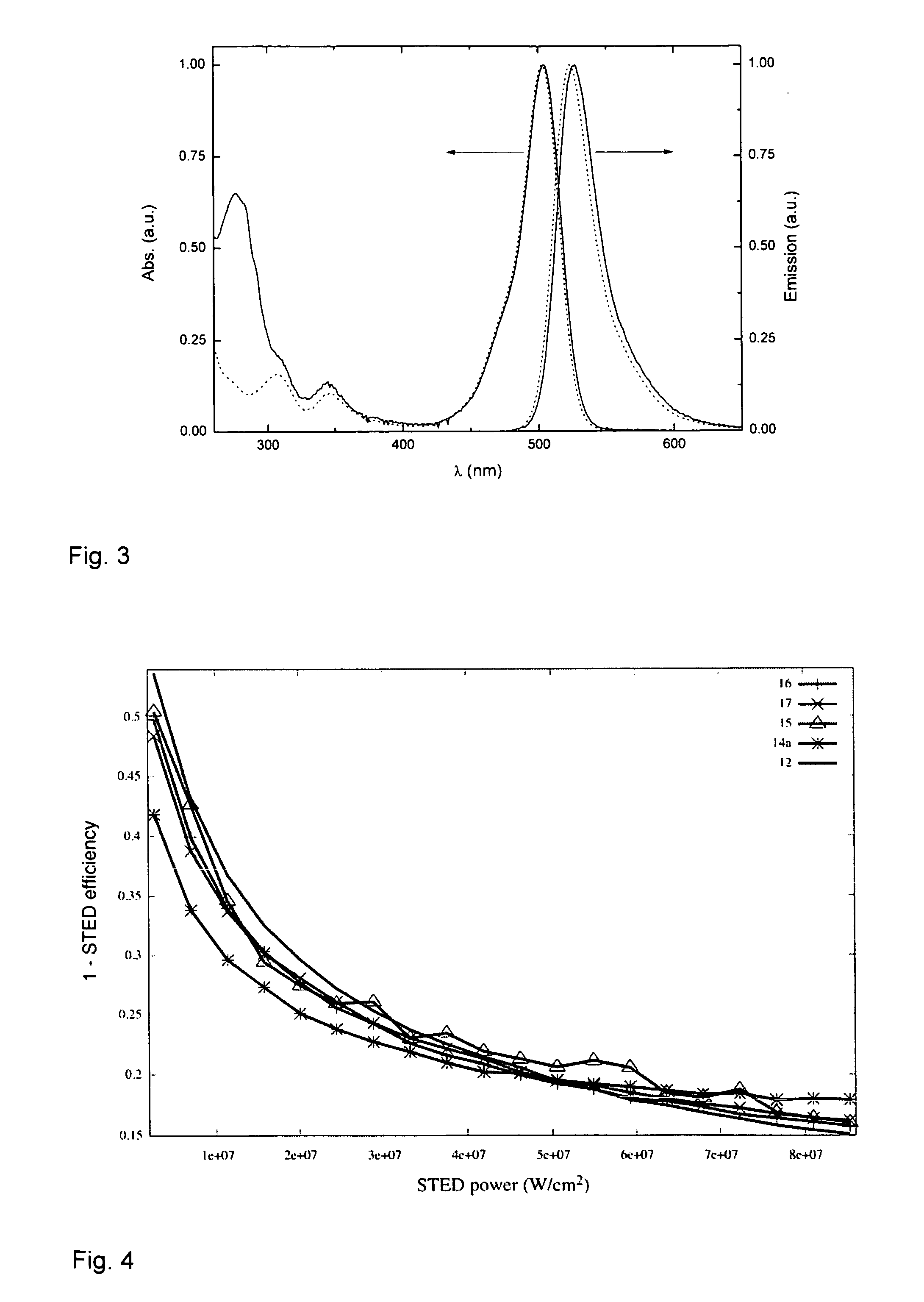Novel fluorinated rhodamines as photostable fluorescent dyes for labelling and imaging techniques
- Summary
- Abstract
- Description
- Claims
- Application Information
AI Technical Summary
Benefits of technology
Problems solved by technology
Method used
Image
Examples
example 1
Synthesis of nitro compounds 31-NO2, 32-NO2—H and 32-NO2-Me
[0092]2-Fluoro-N,N-dimethyl-5-nitroaniline (31-NO2): N,N-Dimethylation of 2-fluoro-5-nitroaniline was performed according to a general method described by A. G. Giumanini et al., Synthesis 1980, 743-746. Specifically, 2-fluoro-5-nitroaniline (ALFA AESAR, 98%, 3.33 g, 21.3 mmol) and finely crushed NaBH4 (4.73 g, 125 mmol) were suspended in THF (50 mL) and this slurry was added in small portions to a stirred solution of 3 M aq. H2 SO4 (5.5 mL, 16.5 mmol) and 35% aq. formaldehyde (6.5 ml, 8.6 mmol) in THF (50 mL). After the first half of the mixture was added, the reaction mixture was acidified with 3 M aq. H2 SO4 (5.50 mL, 16.5 mmol), and the addition was continued. Then 1 M aq. KOH was added to the reaction mixture until it became strongly basic. The organic phase was separated, and the aqueous phase was extracted with ether (2×50 mL). Combined organic solutions were washed with brine (2×100 mL), and dried with Na2 SO4. After...
example 2
Reduction of Nitro Compounds 31-NO2, 32-NO2—H and 32-NO2-Me into Anilines 31-NH2, 32-NH2—H and 32-NH2-Me (General Method (1))
[0095]5-Amino-2-fluoro-N-(trifluoroacetyl)aniline (32-NH2—H): A Schlenk-flask (250 mL) was evacuated and flushed with argon two times. Then 10% Pd / C (0.74 g, VWR International, oxidized form) and EtOAc (30 mL) were placed into it, and the flask was closed with a septum. The mixture was flushed with hydrogen and stirred vigorously to activate the catalyst. Then 32-NO2—H (5.14 g, 20.4 mmol) in 20 mL of EtOAc was added by syringe through a septum. (Addition was accompanied by the exothermic reaction). The solution was hydrogenated for 4 h at 20° C. Then hydrogen was replaced by argon and the mixture was filtered through Celite®. The filter-cake was washed with EtOAc (2×50 mL) and the solvent was evaporated in vacuo to yield the title compound as a brownish solid with m.p. 116-118° C.; yield—4.35 g (96%). 1H NMR (CDCl3, 300 MHz, ppm): δ=3.30 (br. s, 3H, NH2), 6.44...
example 3
Diazotation of Anilines 32-NH2—H, 32-NH2-Me, 31-NH2 and Conversion into Phenols 32-OH—H, 32-OH-Me and 31-OH (General Method (2))
[0098]2-Fluoro-5-hydroxy-N-trifluoroacetylaniline (2-OH—H): Compound 32-NH2—H (248 mg, 1.12 mmol) was dissolved in 35% aq. H2 SO4 (2 mL) cooled to 0° C., and NaNO2 (96.6 mg 1.4 mmol) in water (1 mL) was added carefully through a Teflon® tube to the bottom of the flask. An exothermic reaction was observed and the brown gas evolved. The mixture was stirred for 5 min, several crystals of urea were added to the reaction mixture, and then the reaction solution was transferred into the blue solution of Cu(NO3)2*3H2O (3.75 g, 15.5 mmol) in water (36 mL). The color of the solution changed to green. With vigorous stirring, the powder of Cu2O (132 mg, 0.920 mmol) was added, and the evolution of nitrogen was complete in several minutes. The reaction mixture was extracted with ether (3×200 mL); combined organic solutions were washed with brine (100 mL) and dried. The s...
PUM
| Property | Measurement | Unit |
|---|---|---|
| Temperature | aaaaa | aaaaa |
| Temperature | aaaaa | aaaaa |
| Fraction | aaaaa | aaaaa |
Abstract
Description
Claims
Application Information
 Login to View More
Login to View More - R&D
- Intellectual Property
- Life Sciences
- Materials
- Tech Scout
- Unparalleled Data Quality
- Higher Quality Content
- 60% Fewer Hallucinations
Browse by: Latest US Patents, China's latest patents, Technical Efficacy Thesaurus, Application Domain, Technology Topic, Popular Technical Reports.
© 2025 PatSnap. All rights reserved.Legal|Privacy policy|Modern Slavery Act Transparency Statement|Sitemap|About US| Contact US: help@patsnap.com



